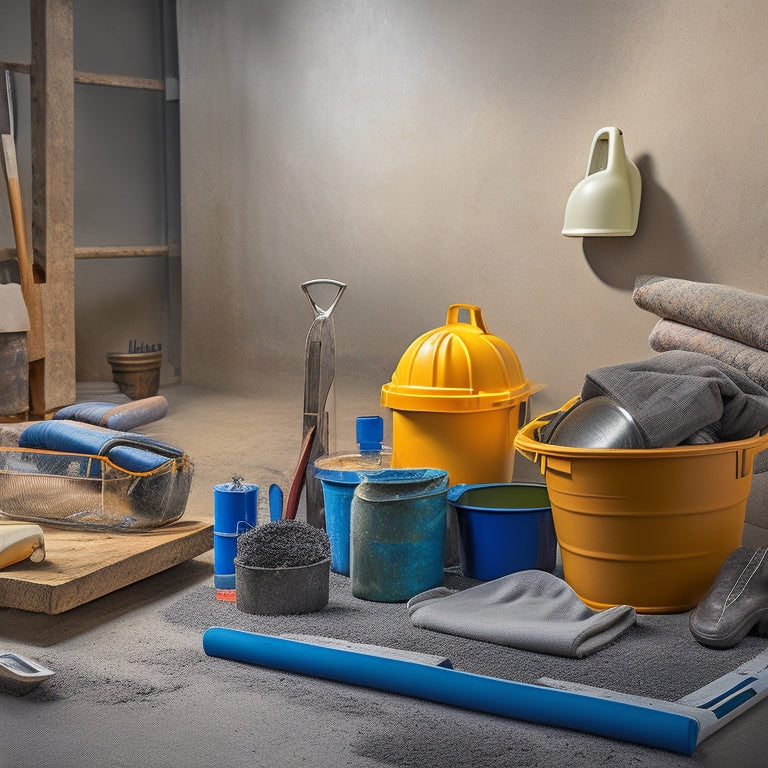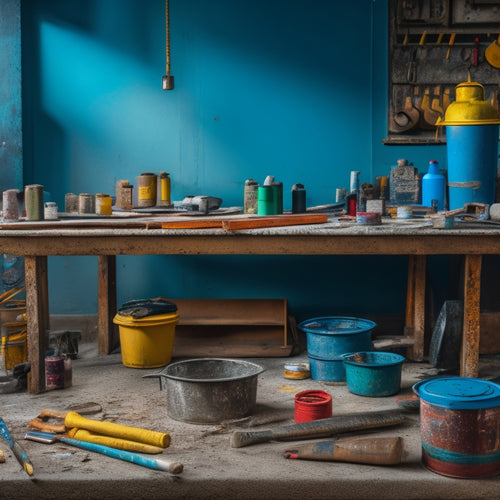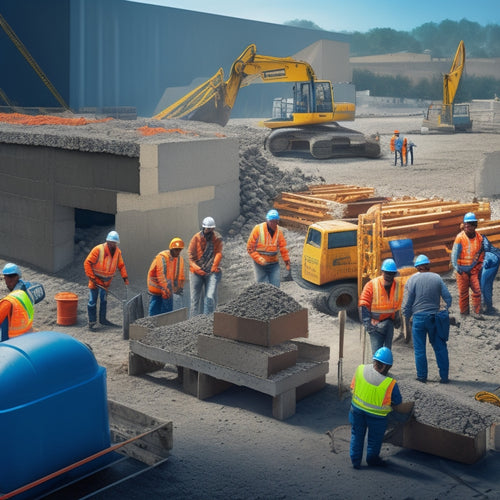
What Tools Do You Need for Premixed Concrete
Share
When working with premixed concrete, you'll need a range of specialized tools to guarantee a professional finish. For a smooth, uniform surface, you'll require tamping and leveling tools, such as hand tampers and spirit levels. Mixing and blending tools, like mixing buckets and power mixers, are essential for achieving a consistent mix. Cutting and shaping tools, including concrete saws and grinders, enable precise dimensions and profiles. Additionally, you'll need finishing and smoothing tools, such as trowels and edgers, as well as laying, spreading, and compacting tools, like screeds and plate compactors. By having these tools at your disposal, you'll be well on your way to achieving a high-quality finish, and exploring more advanced techniques will help you take your project to the next level.
Key Takeaways
• Essential tools for premixed concrete include tamping, leveling, mixing, cutting, and finishing tools for a smooth and uniform finish.
• Tamping and leveling tools remove air pockets, excess water, and ensure a compacted and level surface.
• Mixing and blending tools provide a uniform, lump-free consistency, following the manufacturer's mixing ratio instructions.
• Cutting and shaping tools, such as concrete saws and grinders, create precise dimensions and profiles in concrete.
• Finishing and smoothing tools, including trowels, edgers, and floating techniques, achieve a high-quality, professional finish.
Tamping and Leveling Tools
When working with premixed concrete, you'll need to secure the surface is even and compacted, which is where tamping and leveling tools come into play.
These tools are vital for achieving a smooth, uniform finish and making sure the concrete sets properly. Tamping tools, such as hand tampers or plate compactors, help to remove air pockets and excess water, resulting in a dense, strong concrete surface.
To get the most out of your tamping techniques, use a combination of gentle and firm strokes, working in small sections to avoid creating unevenness.
In addition to tamping, leveling strategies are important for achieving a perfectly flat surface. Leveling tools, such as spirit levels or laser levels, help you detect even the slightest deviations from the desired plane.
By using these tools in conjunction with your tamping techniques, you can secure a surface that's not only compacted but also precisely level.
Mixing and Blending Tools
Mixing and blending premixed concrete to the right consistency is vital, and that's where mixing and blending tools come in, helping you achieve a uniform, lump-free mixture.
You'll need a range of tools to guarantee accurate mixing ratios and effective blending techniques. A mixing bucket or drum is a must-have, as it provides a clean and stable environment for mixing. A mixing stick or paddle is also vital, allowing you to scoop, mix, and blend the concrete with ease. For larger projects, consider investing in a power mixer or drill with a mixing paddle attachment. This will enable you to mix large quantities quickly and efficiently.
When it comes to blending techniques, it's important to follow the manufacturer's instructions for mixing ratios. Over-mixing can lead to a weak and porous finish, while under-mixing can result in a rough, uneven surface.
Cutting and Shaping Tools
Cutting and shaping premixed concrete to precise dimensions and profiles requires an array of specialized tools, which you'll need to master for a professional-looking finish.
To achieve precise cuts, you'll need concrete saws, such as circular saws or reciprocating saws, equipped with diamond-tipped blades. These blades can withstand the abrasive nature of concrete, allowing for clean cuts with minimal dust and debris. For more intricate cuts, you may need to use specialized cutting techniques, such as plunge cutting or bevel cutting, which require a high degree of precision and control.
In addition to cutting tools, you'll also need shaping methods to refine the concrete's profile. Concrete grinders, for instance, can be used to smooth out rough edges or create a textured finish. Chisels and hand tools can also be employed to remove excess material or create decorative features.
Finishing and Smoothing Tools
When you're working with premixed concrete, you'll need to switch to finishing and smoothing tools to achieve a professional-looking finish.
You'll use trowels and edgers to create a smooth surface, and then move on to floating and finishing techniques to remove any imperfections.
Next, you'll focus on smoothing and leveling the concrete to achieve a uniform surface.
Trowel and Edger Uses
You'll typically use a trowel to apply and smooth out a thin layer of premixed concrete, allowing you to achieve a uniform surface finish.
Mastering trowel techniques is essential in this stage, as it enables you to spread the concrete evenly and remove excess material. By holding the trowel at a 45-degree angle, you can effectively press the concrete into place and eliminate air pockets.
Once you've achieved a smooth surface, it's time to use an edger to create a clean, defined edge. The edger benefits include precision and control, allowing you to create sharp, crisp lines.
You can use the edger to create a decorative edge or to simply define the border of your concrete project. When using an edger, make sure to hold it at a consistent angle and apply gentle to moderate pressure, depending on the type of concrete and the desired finish.
Floating and Finishing
Floating and Finishing
With the surface prepared, you're ready to float the concrete using a bull float or darby, which helps to further compact and smooth the material, eliminating any remaining air pockets and imperfections. This step is essential in achieving the desired finish texture.
| Float Techniques | Finish Textures |
|---|---|
| Bull float | Smooth, even finish |
| Darby | Fine, detailed finish |
| Tamping float | Dense, compacted finish |
| Power float | High-gloss, polished finish |
As you float the concrete, you'll need to apply the right amount of pressure and use the correct float techniques to achieve the desired finish. Remember to work in sections, using long, smooth strokes to cover the entire area. This will help you maintain consistency and avoid creating unevenness. By mastering the art of floating and finishing, you'll be able to achieve a high-quality, professional-looking finish that meets your project's requirements.
Smoothing and Leveling
Now that the concrete has been floated, use finishing and smoothing tools to refine the surface, ensuring it's even and level. You'll need a range of tools to achieve a smooth, high-quality finish. A tamping tool or bull float is essential for removing excess water and air pockets, while a darby or straightedge helps to flatten and level the surface.
For more precise smoothing techniques, use a hand trowel or finishing trowel to remove minor imperfections and create a uniform finish.
When it comes to leveling strategies, a spirit level and a laser level are must-haves. These tools allow you to accurately assess the surface and make adjustments as needed. A screed board or leveling rake can also be used to level the concrete, ensuring it's perfectly even.
Remember to work in small sections, using overlapping strokes to maintain consistency and prevent marks. By mastering these smoothing and leveling techniques, you'll be able to achieve a professional-grade finish that's both durable and visually appealing.
Laying and Spreading Tools
Laying and spreading tools, such as tamping tools, screeds, and floats, enable you to distribute and level premixed concrete efficiently and accurately.
When it comes to spreading premixed concrete, you'll need to choose the right spreader type for the job. There are two main types: manual and power-driven spreaders. Manual spreaders, like tamping tools and screeds, are ideal for small to medium-sized projects, while power-driven spreaders, like ride-on screeds, are better suited for larger projects.
To achieve a smooth and even finish, you'll need to master various application techniques. For instance, you can use a screed to strike off excess concrete and create a level surface. Then, use a float to further smooth out the surface and remove any imperfections. Additionally, you can use a tamping tool to compact the concrete and guarantee it's evenly distributed.
Compacting and Vibrating Tools
When working with premixed concrete, you'll need to verify it's properly compacted and vibrated to achieve the desired strength and finish.
To get the job done efficiently, you'll want to choose the right tools for the task, including hand tampers, plate compactors, and vibrators.
Hand Tamper Options
By compacting freshly poured concrete, you can effectively remove air pockets and excess water with hand tamper options that provide a combination of compacting and vibrating actions.
Hand tamper options are essential for achieving a strong, durable, and even concrete surface. There are various hand tamper types to choose from, including bull float tampers, hand float tampers, and tamper rakes. Each type is designed for specific concrete applications and provides unique benefits.
The benefits of using hand tampers include improved concrete density, reduced settling and shrinkage, and enhanced surface finish. Hand tampers also help to eliminate honeycombing and reduce the risk of delamination.
Additionally, they enable you to work efficiently and effectively, even in tight spaces or areas with limited access. With the right hand tamper, you can achieve professional-grade results and guarantee your concrete projects meet the highest standards.
Plate Compactor Uses
You'll achieve ideal concrete consolidation and surface finishing with plate compactors, which combine compacting and vibrating actions to eliminate air pockets and excess water.
These powerful tools guarantee a dense, uniform finish, making them essential for large-scale concrete projects. One of the significant plate compactor benefits is their ability to reduce labor costs and time. By efficiently compacting concrete, you'll minimize the risk of settlement cracks and improve the overall structural integrity of the concrete.
To guarantee peak performance, it's vital to perform regular plate compactor maintenance. This includes checking and maintaining the correct oil levels, cleaning the compactor plate, and inspecting the vibrating mechanism for any signs of wear.
Additionally, always follow the manufacturer's guidelines for operation, maintenance, and repair to extend the lifespan of your plate compactor. By incorporating a plate compactor into your concrete finishing process, you'll experience improved results, increased productivity, and reduced costs.
With proper maintenance, these powerful tools will become a valuable asset to your concrete finishing arsenal.
Vibrator Selection Tips
Selecting the right vibrator for your concrete application depends on factors such as the type of concrete, slab thickness, and desired finish.
You'll need to take into account the vibrator's power, frequency, and amplitude to guarantee you get the desired results. There are several vibrator types to choose from, including electric, pneumatic, and hydraulic models. Each has its own strengths and weaknesses, so it's important to select the right one for your specific needs.
When choosing a vibrator, pay attention to the vibration frequency, which is usually measured in vibrations per minute (vpm). A higher frequency is usually required for thicker slabs or more viscous concrete.
You'll also need to take into account the amplitude, which affects the intensity of the vibrations. A higher amplitude can be more effective at removing air pockets and consolidating the concrete, but it may also increase the risk of over-vibration.
Measuring and Marking Tools
Measure the premixed concrete accurately with measuring cups, scoops, or buckets to ascertain the correct mix ratio and avoid costly mistakes.
When it comes to measuring techniques, you'll want to make certain you're using the right tools for the job. Measuring cups and scoops are ideal for small to medium-sized projects, while buckets are better suited for larger applications. Regardless of the tool you choose, make sure it's clean and dry to prevent contamination and guarantee accurate measurements.
Marking accuracy is also essential when working with premixed concrete. You'll need a reliable marker or chalk line to mark the area where you'll be pouring the concrete. This is especially important when working with complex designs or patterns.
A high-visibility marker or chalk line will help you achieve precise markings, ensuring your finished product looks professional and well-crafted.
Handling and Lifting Tools
When pouring and placing premixed concrete, having the right handling and lifting tools is essential to efficiently manage the material's weight and flow.
You'll need equipment that enables you to handle the concrete without compromising its integrity or your safety. A sturdy wheelbarrow or concrete buggy is a must-have for transporting heavy loads around the site. You'll also need shovels, trowels, and rakes to manage the concrete's flow and finish.
Proper lifting techniques are vital to avoid injuries and prevent damage to the concrete. You should always use your leg muscles to lift, keeping the load close to your body and avoiding twisting or jerking motions.
Safety equipment such as gloves, safety glasses, and a hard hat are also essential to protect yourself from potential hazards.
Consider investing in a lifting aid like a concrete lifting strap or a vacuum lifter to make the process easier and safer.
Cleaning and Curing Tools
You'll need to switch your focus from handling and lifting to cleaning and curing, as the concrete's surface finish and long-term durability depend on the right tools for these critical tasks.
Cleaning techniques are essential to remove excess concrete, dirt, and other contaminants that can compromise the finish. You'll need a range of cleaning tools, including wire brushes, brooms, and scrubbers, to tackle different surfaces and contaminants. For large areas, power washers or ride-on scrubbers can be effective.
Curing methods are equally important to guarantee the concrete cures properly and reaches its maximum strength. You'll need to apply a curing compound to prevent moisture loss and promote hydration. Curing tools like sprayers, rollers, and squeegees will help you apply the compound evenly and efficiently.
Additionally, you may need to use specialized tools like curing blankets or evaporation retarders, depending on the specific project requirements. By investing in the right cleaning and curing tools, you'll be able to achieve a high-quality finish and guarantee the long-term durability of your concrete project.
Frequently Asked Questions
Can I Use Premixed Concrete for Large Construction Projects?
When planning a large construction project, you're wondering if premixed concrete is a viable option.
While premixed concrete is convenient, its applications are generally limited to smaller-scale projects or specific uses like repairing sidewalks or setting posts.
For large project considerations, you'll likely need a custom mix to guarantee the right strength, consistency, and durability.
It's crucial to assess your project's requirements before deciding on a concrete solution.
How Long Does Premixed Concrete Take to Set Completely?
As you pour the premixed concrete, time becomes a ticking clock, and you're racing against the setting time.
The curing process is a delicate dance, where every minute counts.
You'll need to wait around 24 to 48 hours for the concrete to set completely, depending on the mix and environmental conditions.
But don't rush it - a proper cure is essential for strength and durability.
Can I Color or Pigment Premixed Concrete for Decorative Purposes?
You can definitely add a personal touch to your premixed concrete project by incorporating color additives for decorative purposes.
These additives allow you to achieve unique, vibrant hues that enhance the aesthetic appeal of your finished product.
Is Premixed Concrete Suitable for Outdoor or Exposed Areas?
When you're planning to use premixed concrete in outdoor or exposed areas, you'll need to take into account the weather conditions it'll be subjected to.
Will it face direct sunlight, heavy rainfall, or extreme temperatures?
Proper surface preparation is essential to guarantee a strong bond between the old and new concrete.
You'll need to clean and prepare the surface, removing any dirt or debris, and apply a bonding agent if necessary.
Can I Return or Exchange Unused Premixed Concrete Bags?
Did you know that over 10% of building materials end up in landfills due to improper storage?
When it comes to unused premixed concrete bags, you'll want to check the return policy of the supplier or retailer. Typically, unopened bags can be returned or exchanged within a certain timeframe.
Proper concrete storage is essential to maintain the product's quality, so make certain to follow the manufacturer's guidelines to guarantee you can utilize the material or return it if needed.
Conclusion
As you stand before your premixed concrete project, you're about to release a transformation.
The right tools at your disposal will make all the difference. You've got the essentials: tamping and leveling, mixing and blending, cutting and shaping, finishing and smoothing, laying and spreading, compacting and vibrating, measuring and marking, handling and lifting, and cleaning and curing tools.
Now, imagine the concrete taking shape, the surface glistening, and the structure rising.
The final product is within reach. Will you bring it to life?
Related Posts
-

Essential Tools for Painting Concrete Walls
When painting concrete walls, you'll need a range of specialized tools to achieve a professional-looking finish. Star...
-

Must-Have Tools for Laying Concrete Tiles
When laying concrete tiles, you'll need a range of essential tools to get the job done right. Start with subfloor pre...
-

7 Best Tools for Concrete Block Construction
You'll need a solid foundation, precise cutting, and seamless finishing to guarantee your concrete block construction...


